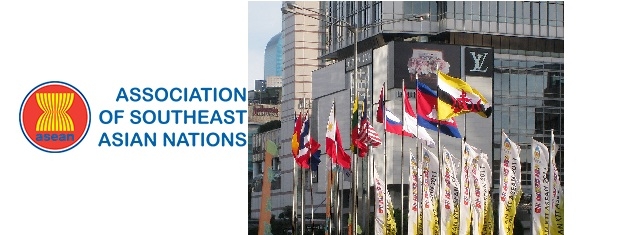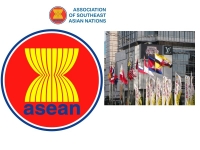Miscellaneous
THE US AND ASEAN COUNTRIES HELD AN INFORMAL LEADERS MEETING IN CALIFORNIA
CHINESE PRESS CONFERENCE ON FEBRUARY 17

ASEAN MEMBERS' FLAGS IN JAKARTA (Source: Wikipedia)
USPA NEWS -
Chinese Foreign Ministry Spokesperson Hong Lei' s held a Press Conference on February 17, 2016 regarding The United States and the Association of Southeast Asian Nations (ASEAN) countries holding an informal leaders' meeting in California...
Chinese Foreign Ministry Spokesperson Hong Lei' s held a Press Conference on February 17, 2016 regarding The United States and the Association of Southeast Asian Nations (ASEAN) countries holding an informal leaders' meeting in California.
Chinese Foreign Ministry Spokesperson Hong Lei was answering Journalists questions :
QUESTION : The US and ASEAN countries held an informal leaders' meeting in California. The meeting issued a joint statement which included contents like peacefully resolving disputes and maintaining regional and maritime peace and security. What is China's comment ?
Chinese Foreign Ministry Spokesperson Hong Lei was answering Journalists questions :
QUESTION : The US and ASEAN countries held an informal leaders' meeting in California. The meeting issued a joint statement which included contents like peacefully resolving disputes and maintaining regional and maritime peace and security. What is China's comment ?
ANSWER : We have pointed out before that we welcome the development of relations between the US and ASEAN. We also believe that their relations should be conducive to positive interaction and cooperation between all parties in the region as well as regional stability and development.
We have noted that some countries tried to use this meeting to hype up the South China Sea issue. But the majority of ASEAN countries disagreed, believing that it would only undermine mutual trust between regional countries, disrupt or even sabotage the efforts made by regional countries to safeguard peace and stability in the South China Sea.
We have noted that some countries tried to use this meeting to hype up the South China Sea issue. But the majority of ASEAN countries disagreed, believing that it would only undermine mutual trust between regional countries, disrupt or even sabotage the efforts made by regional countries to safeguard peace and stability in the South China Sea.
The Chinese side is willing to make joint efforts with ASEAN countries and continue to play a constructive role in upholding region peace and stability and advancing the peaceful resolution of relevant disputes.
QUESTION : US President Barack Obama told the press after the US-ASEAN informal leaders' meeting that all parties should peacefully resolve the South China Sea dispute through arbitration. He called for a halt to further reclamation, new construction and militarization of disputed areas in the South China Sea, and said the US would continue to sail, fly and operate in areas wherever international law allows. What is China's comment ?
QUESTION : US President Barack Obama told the press after the US-ASEAN informal leaders' meeting that all parties should peacefully resolve the South China Sea dispute through arbitration. He called for a halt to further reclamation, new construction and militarization of disputed areas in the South China Sea, and said the US would continue to sail, fly and operate in areas wherever international law allows. What is China's comment ?
ANSWER : We have noted relevant reports. In fact, this is not the first time that the US leader made such remarks on the South China Sea issue. The US is not a party concerned in the issue. It should speak and act prudently and create favorable conditions for parties directly concerned to peacefully resolve relevant disputes through consultations and negotiations, instead of exploiting the occasion to hype up the South China Sea issue, sensationalizing tensions, and driving a wedge among regional countries.
QUESTION : The US-ASEAN relationship was elevated to a strategic partnership last November. This time, the US and ASEAN held an informal leaders' meeting. As an important dialogue and strategic partner of ASEAN, what is China's reaction ?
ANSWER : The Chinese side attaches great importance and stays committed to developing relations with ASEAN. We are glad to see ASEAN conduct amicable cooperation with all dialogue partners and contribute positively to promoting regional peace, stability and development.
ANSWER : The Chinese side attaches great importance and stays committed to developing relations with ASEAN. We are glad to see ASEAN conduct amicable cooperation with all dialogue partners and contribute positively to promoting regional peace, stability and development.
China is ASEAN's most active and special dialogue partner. China and ASEAN countries are friendly neighbors linked by mountains, rivers and seas. China established dialogue partnership with ASEAN as early as 1991 and forged strategic partnership in 2003, becoming the first dialogue partner to establish strategic partnership with ASEAN. The two sides have been solidifying political mutual trust and harvesting fruitful results from practical cooperation in various fields. China is the first to establish a Free Trade Area (FTA) with ASEAN and has been ASEAN's largest trading partner for seven years in a row.
Last year, the value of bilateral trade reached US$ 472.2 billion. Two-way non-financial direct investment accumulated to US$ 150 billion. More than 18 million visits were exchanged between the two sides. During the China-ASEAN Summit held last November, the two sides successfully signed a protocol to upgrade the FTA and formulated the third five-year action plan to implement bilateral strategic partnership and chart the course for cooperation in the next five years.
This year, which marks the 25th anniversary of the establishment of China-ASEAN dialogue relations and the year of China-ASEAN educational exchanges, is significant for bilateral relations to build on the past and open up the future. The two sides will hold a commemorative summit on the 25th anniversary of the establishment of China-ASEAN dialogue relations this September. We look forward to working with ASEAN to hold a series of commemorative activities, deepen practical cooperation in various fields, and advance China-ASEAN relations to a greater height.
QUESTION : The US side expressed its support for the building of ASEAN Community. What will China do to support the building of ASEAN Community ?
ANSWER : This year is the first year of ASEAN Community. China is glad to see the achievements of ASEAN integration. We have also noted that development is still the primary task for ASEAN countries which still face the problem of imbalanced development.
ANSWER : This year is the first year of ASEAN Community. China is glad to see the achievements of ASEAN integration. We have also noted that development is still the primary task for ASEAN countries which still face the problem of imbalanced development.
As an important cooperation partner for ASEAN, China firmly supports the building of ASEAN Community and stays committed to narrowing development gaps among ASEAN countries and driving common development of the region while promoting China-ASEAN all-around cooperation. At the 17th China-ASEAN Summit held in 2014, Premier Li Keqiang's proposal to set up a Lancang-Mekong River cooperation mechanism was positively received by all sides. Last November, China and five countries along the Mekong River, Cambodia, Laos, Myanmar, Thailand and Vietnam, held the first foreign ministers' meeting on Lancang-Mekong River cooperation in Jinghong, Yunan, during which the Lancang-Mekong River cooperation process was officially launched.
As agreed by all, the first leaders' meeting on Lancang-Mekong River cooperation will be held in Sanya, Hainan in the latter half of this March, during which leaders of the six countries will get together to paint a blueprint for cooperation. To lay a good groundwork for the leaders' meeting, China and five Mekong River countries will hold a senior diplomatic officials' meeting next Wednesday. We believe that Lancang-Mekong River cooperation will be a helpful supplement to China-ASEAN cooperation and a strong boost to ASEAN Community building and regional integration.
QUESTION : The Huffington Post carried an article saying that the informal leaders' meeting between the US and ASEAN shows that the US regards the region as the hinge of its "pivot to Asia" strategy. The US wants to contain China by cozying up to regional countries. It is a Cold War mentality. Looking back on the warring history between the UK and the US at sea, the US perhaps should let China peacefully rise to a regional power. What is your comment ?
ANSWER : I have noted this report from the American press. Today's world is witnessing the forging of a community of common interests and common destiny where countries depend upon each other and share together danger and safety, regardless of their geographical locations and sizes. What China and the US need is a new path that benefits not only the two countries but also the whole world, instead of the beaten track where established and rising powers collide. The Pacific Ocean is big enough for China and the US to develop together. Our interaction in the Asia-Pacific region should be guided by the concept of building a new type of major-country relations.
That is what we need to stick to so that people of the two countries, in the Asia-Pacific region, and around the world can all benefit.
QUESTION : It is reported that China has deployed surface-to-air missiles in Yongxing Dao. Why does China choose to place military facilities at this time ? Some analysts believe that this runs counter to China's commitment to non-militarization of the South China Sea. What is your comment ?
QUESTION : It is reported that China has deployed surface-to-air missiles in Yongxing Dao. Why does China choose to place military facilities at this time ? Some analysts believe that this runs counter to China's commitment to non-militarization of the South China Sea. What is your comment ?
ANSWER : I am not aware of the specific situation. But I want to point out that the Xisha Islands are China's inherent territory. China is entitled to deploy necessary defense facilities on its own territory and enhance national defense capabilities. It has nothing to do with militarization.
QUESTION : Foreign Minister Wang Yi today proposed to move forward denuclearization on the Korean Peninsula in parallel with transition from armistice to peace. Does that mean replacing the armistice mechanism on the Korean Peninsula with a peace regime ? Is China going to pursue this approach under the framework of the Six-Party Talks ?
QUESTION : Foreign Minister Wang Yi today proposed to move forward denuclearization on the Korean Peninsula in parallel with transition from armistice to peace. Does that mean replacing the armistice mechanism on the Korean Peninsula with a peace regime ? Is China going to pursue this approach under the framework of the Six-Party Talks ?
ANSWER : Your understanding is correct. As Foreign Minister Wang Yi said, the approach of advancing denuclearization on the Korean Peninsula in parallel with transition from armistice to peace is to replace the armistice mechanism on the Korean Peninsula with a peace regime and deliver long-term stability to Northeast Asia.The purpose is to address all parties' major concerns in a balanced manner, lay down the objectives of dialogues and negotiations, and find a breakthrough to resume talks as soon as possible.
We believe that this approach is conducive to fundamentally addressing the nuclear issue on the Korean Peninsula. China will remain in close communication with all relevant parties of the Six-Party Talks on that.
(...)
TO BE CONTINUED FINAL PART...
Source : Chinese Ministry of Foreign Affairs - On February 17, 2016
Ruby BIRD
http://www.portfolio.uspa24.com/
(...)
TO BE CONTINUED FINAL PART...
Source : Chinese Ministry of Foreign Affairs - On February 17, 2016
Ruby BIRD
http://www.portfolio.uspa24.com/
Ruby Bird Yasmina Beddou Washington Asean China Informal Leaders Meeting California Press Conference Foreign Ministry Spokesperson Hong Lei
Liability for this article lies with the author, who also holds the copyright. Editorial content from USPA may be quoted on other websites as long as the quote comprises no more than 5% of the entire text, is marked as such and the source is named (via hyperlink).






